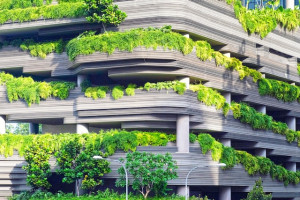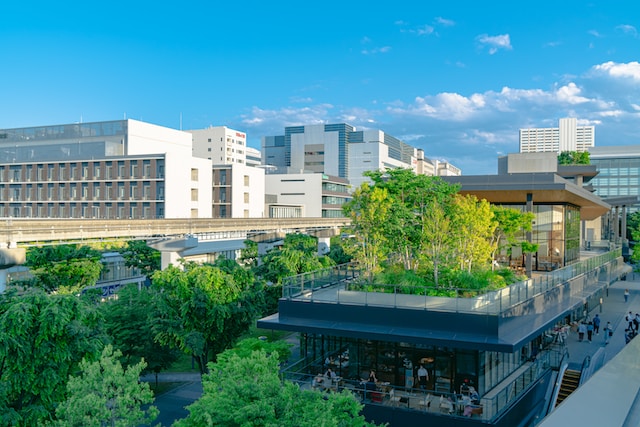Introduction to Green Architecture
In today’s world, where environmental concerns are more pressing than ever, the concept of Green Architecture has emerged as a beacon of hope. But what exactly is Green Architecture? Well, it’s a design approach that puts nature and sustainability at the forefront of constructing buildings. In simpler terms, it’s like building structures that are like good friends with the environment, not foes.
Imagine a world where buildings are more than just concrete and steel; they’re like living organisms that work together with nature. That’s what Green Architecture aims to achieve. Green architecture is more than aesthetic; it is about creating spaces that promote health for both people and planet. Green Architecture didn’t emerge out of nowhere; rather it has evolved through time. It’s been a journey of evolution. Back in the day, people built houses with whatever materials were at hand – think mud, wood, and straw. But as times changed, so did our methods. We started using more concrete, which might seem strong, but it’s not exactly besties with the environment.
And that’s where the significance of Green Architecture shines. It’s like a superhuman dipping in to make all the difference. Instead of bulldozing forests for materials, it encourages us to work with what nature provides. It’s about using sustainable materials that don’t harm the planet, like recycling old stuff and using things like bamboo and hemp to build. So, Green Architecture isn’t just about creating cool-looking structures; it’s about being kind to the Earth.

Core Principles of Green Architecture
Harmonizing with Nature
One of the coolest things about Green Architecture is how it dances to the tune of nature. Instead of forcing buildings into landscapes, it’s all about fitting them in like pieces of a puzzle. Imagine a house that’s built around a big, old tree instead of cutting it down – that’s the magic of harmonizing with nature. It’s like giving the environment a high-five instead of a punch.
Energy Efficiency and Conservation
Now, let’s talk about energy – the stuff that makes our gadgets work and our lights shine. Green Architecture is like the energy-saving champ. Utilizing less power is the goal. An example would be buildings equipped with smart insulation that keeps warm air inside during winter and cool air inside during summer, keeping temperatures comfortably inside the buildings year round. It’s like wearing a cozy sweater when it’s chilly outside.
Minimizing Environmental Footprint
Have you heard of carbon footprints? It’s like the trail we leave behind when we use energy and resources. Green Architecture is all about tiptoeing instead of stomping. Environmentalism seeks to minimize our impact on the planet by using less resources and producing less waste – much like building a sandcastle without using all the sand available – leaving some for future use at the beach.
Innovations in Sustainable Materials
Recycled and Upcycled Elements
Heard the recognizable saying: ” One person’s garbage is another’s fortune”? Well, Green Architecture takes that notion one step further. Instead of tossing things away, it turns them into building blocks. Imagine using old glass bottles to make colorful walls or discarded wood to create beautiful floors. It’s like giving stuff a second chance to shine.
Biomaterials Revolutionizing Construction
Biomaterials might seem like something out of a science fiction film, but they’re actually real and shaping architecture today. Made up of materials made from plants and bacteria – yes! You read that right! – these innovative building materials have revolutionized architectural practice. Imagine a building material that grows on its own or repairs itself when it gets a little damaged. It’s like having a self-healing superhero in the world of construction.
The Role of Solar Energy in Green Architecture
Harnessing Sun’s Power: Photovoltaics
Consider the sun: an immense, radiating source of energy bursting through the atmosphere. Green Architecture has found a way to use that sun energy as electricity through photovoltaic solar panels! They act like small sun catchers that absorb sunshine before turning it into power – like having many sun-powered generators on your roof!
Sun based and Warm Intensity Siphon Frameworks for Warming and Cooling
Sun based energy can accomplish more than create power – it can likewise be utilized to intensity and cool structures! Solar-thermal systems act like magic mirrors by focusing the sun onto solar-thermal collectors that concentrate sunlight into heat sources. So, when it’s chilly outside, these systems warm up the indoors, and when it’s hot, they cool things down. It resembles having your own climate regulator.
Integrating Natural Ventilation and Cooling
When it comes to keeping our buildings cool, we don’t always need fancy gadgets and electricity-hungry machines. Sometimes, nature itself can lend a helping hand. That’s where the magic of natural ventilation and passive cooling techniques comes into play.
Passive Cooling Techniques
Passive cooling is like inviting a cool breeze to your party without sending out an invitation. It’s all about using smart design to let air flow naturally and keep things comfortable. Imagine having windows strategically placed to catch the wind and carry it through your home, cooling it down without needing a power-hungry air conditioner. It’s like letting nature take care of the cooling bill.
Cross Ventilation: Nature’s Breeze in Architecture
Ever stood between two buildings and felt a sudden rush of wind? That’s cross ventilation working its magic. It’s like creating an invisible wind tunnel that cools down your space naturally. Imagine having windows on opposite sides of a room – when you open them, the fresh air rushes in, and the warm air rushes out. It’s like having your own mini wind power station.
Vertical Gardens: Greening Up Urban Spaces
In the concrete jungles of our cities, a touch of green can make all the difference. That’s where vertical gardens step in. Imagine walls covered in a vibrant tapestry of plants – it’s like giving your building a cozy, living sweater.
Living Facades: Aesthetic and Functional Benefits
Vertical gardens aren’t just pretty to look at; they’re like superheroes of sustainability. They absorb carbon dioxide – the stuff we humans breathe out – and give us back oxygen. Plants bring the outdoors right inside your building and act as natural insulation, keeping the temperature both cooler in summer and warmer in winter. It’s like having a climate control system powered by plants.
Urban Agriculture and Biodiversity Promotion
Now, imagine this – a garden that’s not on the ground but on the side of a building. Vertical gardens can be like mini-farms in the city, growing everything from herbs to veggies. It’s like having your very own garden of flavors right outside your kitchen. And guess what? These green spaces also attract birds, bees, and butterflies, creating a bustling ecosystem even in the heart of the city.
Water Management and Conservation
Water is precious, and in the world of Green Architecture, every drop counts. That’s where water management and conservation techniques come into play, making sure we use this valuable resource wisely.
Rainwater Harvesting Systems
Imagine this: when it rains, instead of the water running down the drains, it’s collected and stored. That’s rainwater harvesting at its finest. It’s like having a special bucket to catch the rain and save it for later. This harvested rainwater can be used for things like watering plants or flushing toilets – it’s like giving the rain a second chance to do some good.
Greywater Recycling for Sustainable Landscaping
What about the water that runs down our sinks and showers? While not entirely pure, it still provides useful services. Greywater recycling is like giving this water a makeover. It’s treated and then used to water gardens and landscapes. Imagine plants getting a drink from the water you used to wash your hands – it’s like a water-saving circle of life.
Net-Zero Energy Buildings: The Ultimate Goal
Imagine a building that produces as much energy as it uses – sounds like something from a sci-fi movie, right? Well, that’s the dream of net-zero energy buildings. These futuristic structures are like superheroes of energy efficiency, and their goal is to give back more than they take.
Net-zero energy buildings are like energy wizards. Innovative technologies use smart technologies to generate electricity from sources like sunlight and wind power. Imagine having solar panels on your roof that soak up sunrays to convert them to electricity; any excess energy they create can even be sent back into the grid as a generous donation back to our planet!
Around the world, architects are working their magic to create net-zero energy buildings that leave a small carbon footprint. Imagine office buildings that have walls covered in solar panels, powering computers and lights without using up fossil fuels. These examples show us that a brighter, greener future is not just a dream – it’s becoming a reality.
Green Roofs and Their Ecological Advantages
Think of a roof covered in plants – that’s a green roof, and it’s more than just eye candy. It’s like giving your building a natural hat that comes with amazing benefits for both people and the planet.
Green roofs act like natural insulation, keeping the building cozy in winter and cool in summer. Imagine having a layer of living plants that shields your home from the harsh elements – it’s like having a built-in blanket for your roof. As an added benefit, rooftop gardens also reduce energy-consuming air conditioner usage – helping the environment immensely!
Imagine creating your very own mini ecosystem on your rooftop where birds, bees and butterflies can enjoy themselves freely! Green roofs are like inviting nature to a rooftop party. They provide habitats for critters that need a place to call home. Plus, these plants are like air purifiers, taking in carbon dioxide and giving us fresh oxygen to breathe. It’s like having a natural air-freshener on your roof.
Adapting Vernacular Architecture for Sustainability
Vernacular architecture might sound like a mouthful, but it’s really about learning from the wisdom of the past. Imagine taking ancient building techniques and giving them a modern twist to create eco-friendly wonders.
Vernacular architecture is like a treasure trove of ancient building knowledge. It’s about using local materials, designs, and techniques that have stood the test of time. Imagine using clay, straw, and wood to create a cozy, energy-efficient home. It’s like bringing the past into the present.
Now imagine those ancient techniques meeting cutting-edge technology. Vernacular architecture can be like a bridge between the old and the new. Integrating tradition and innovation is about crafting buildings that not only function effectively but are also eco-friendly – it’s like having the best of both worlds!
Overcoming Challenges in Green Architecture
Building a greener future presents its share of challenges, but these can be seen as hurdles that just need to be cleared away. These hurdles might appear intimidating at first glance but are easily surmounted.
Economic Viability and Initial Investment
One challenge is the cost – building with sustainability in mind can sometimes be more expensive upfront. Assume spending more upfront to install solar panels or energy-saving systems – but remember the long-term payback can include reduced energy bills and less environmental impact.
Balancing Aesthetics with Eco-Friendliness
Imagine you’re designing a building that’s kind to the Earth, but it also needs to look cool and inviting. Balancing aesthetics with eco-friendliness can be like walking a tightrope. Architects need to find creative ways to make buildings both visually appealing and environmentally conscious. It’s like creating a masterpiece that’s also a planet protector.
Case Studies: Iconic Green Architectural Marvels
Let’s take a look at some amazing green architectural wonders that have won hearts around the globe. Imagine an office building that not only provides work space but is also leading the charge on sustainability initiatives. The Edge in Amsterdam is like a shining example of what green architecture can achieve. It’s got solar panels, energy-efficient lighting, and even a smart system that adjusts the temperature based on how many people are inside. It’s like a building that thinks for itself!
Imagine living in a skyscraper that’s also a lush, green oasis. One Central Park in Sydney is like a vertical garden that reaches for the sky. It’s covered in plants, and even has these cool heliostat mirrors that bounce sunlight into shaded areas. It’s like a jungle in the city, where people and nature coexist in harmony.
The Role of Government Policies and Incentives
Change doesn’t happen in a vacuum; it needs a little push. That’s where government policies and incentives come into play, making green architecture more than just a trend.
Imagine the government saying, “Hey, let’s build greener buildings for a healthier planet.” That’s what regulations do – they set standards for energy efficiency, sustainable materials, and more. It’s like giving architects a roadmap to create eco-friendly wonders.
Now, imagine getting a little reward for choosing the green path. Governments often offer tax benefits or subsidies for building with sustainability in mind. Environmental incentives provide architects and builders with an incentive to embrace green practices more readily and quickly.
Community Engagement and Education
Imagine a world where everyone understands the importance of green architecture. Community engagement and education play a big role in making this dream a reality.
Imagine spreading the word about how our buildings impact the environment. Community engagement is like starting a conversation about green architecture. Show people that their choices matter and that they can contribute to sustainable building practices by becoming aware of their benefits. Doing this increases support and demand for sustainable building practices.
Imagine attending school where learning doesn’t only involve math and history but also building a sustainable future. Seminaries and shops could serve as training grounds for the coming generation of engineers and contrivers. They can learn about energy-effective designs, renewable materials, and the importance of preserving the earth. I like giving them tools to shape a greener world.
Summary: Green Architecture for a Brighter Tomorrow
As we journey through the world of green architecture, we’ve discovered a symphony of innovation, collaboration, and responsibility. From net-zero energy buildings to resilient designs, each concept is like a note in a melody that sings the praises of a sustainable future.
Imagine summarizing all these amazing ideas into a few key points: Green architecture is about designing buildings that work in harmony with nature, rather than against it, using renewable energy, sustainable materials and smart design principles to build brighter futures.
Imagine taking these concepts beyond buildings: green architecture can act as an entryway into living a more sustainable lifestyle – choosing choices that benefit our environment from home design to lifestyle decisions.
Conclusion: Building the Path towards a Greener Future
As we finish exploring green architecture, a powerful truth emerges: we hold the keys to creating a greener and more sustainable future.
Imagine a world in which every building serves as a beacon of sustainability, where cities are alive with green rooftops and homes are powered by renewable sources like the sun. Green architecture is our gateway to this brighter future – so let’s all embrace it now.
Imagine a world in which every decision and brick laid contributes to creating a sustainable planet. Sustainability shouldn’t just be left up to architects and designers; we all play our part. Every decision made today impacts tomorrow; let’s work together towards building a world that benefits both people and planet.

